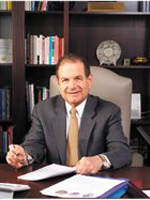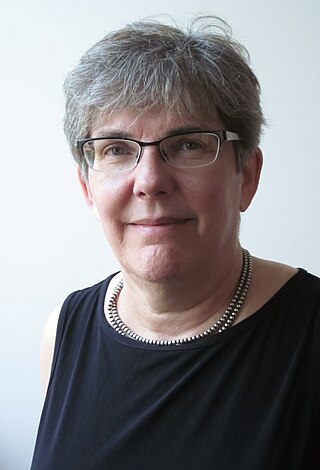Related Research Articles

Carlos José Bustamante is a Peruvian-American scientist. He is a member of the National Academy of Sciences.

Raymond Lee Orbach is an American physicist and administrator. He served as Under Secretary for Science in the United States Department of Energy from 2006 until 2009, when he was replaced by Steven E. Koonin. Until his resignation in December 2012, in the wake of a conflict-of-interest controversy involving the geologist Charles G. Groat, Orbach was Director of the Energy Institute at the University of Texas at Austin.
Robijn F. Bruinsma is a theoretical physicist and is Professor of Physics at the University of California, Los Angeles and Chair of the Department of Theoretical Physics for the Life Sciences at Leiden University. He is a specialist in the theory of condensed matter.
Noemie Benczer Koller is a nuclear physicist. She was the first tenured female professor of Rutgers College.
Timothy Maurice Paul Tait is a Canadian-American particle physicist known for his contributions to the theoretical physics and particle physics, particularly in the field of dark matter. He is currently a professor in the Department of Physics and Astronomy at the University of California, Irvine.
Ann Heinson is an American high-energy particle physicist known for her work on single top quark physics. She established and led the DØ Single Top Group which first published experimental observations of the top quark, and in 1997 she co-authored a paper which laid the foundations for further investigation into the top quark.

Judith P. Klinman is an American chemist, biochemist, and molecular biologist known for her work on enzyme catalysis. She became the first female professor in the physical sciences at the University of California, Berkeley in 1978, where she is now Professor of the Graduate School and Chancellor's Professor. In 2012, she was awarded the National Medal of Science by President Barack Obama. She is a member of the National Academy of Sciences, American Academy of Arts and Sciences, American Association for the Advancement of Science, and the American Philosophical Society.
Andrea Jo-Wei Liu is the Hepburn Professor of Physics at the University of Pennsylvania, where she holds a joint appointment in the Department of Chemistry. She is a theoretical physicist studying condensed matter physics and biophysics. She is particularly known for her study of jamming, a phenomenon in which disordered materials become rigid with increasing density and stress. She is a Simons Investigator and Simons Fellow in Theoretical Physics, fellow of the American Physical Society (APS), the American Association for the Advancement of Science (AAAS), the American Academy of Arts and Sciences, and a member of the National Academy of Sciences (NAS).

Heidi Marie Schellman is an American particle physicist at Oregon State University (OSU), where she heads the Department of Physics. She is an expert in Quantum chromodynamics.
Daniel Ivan Goldman is an experimental physicist regarded for his research on the biomechanics of animal locomotion within complex materials. Goldman is currently a professor at the Georgia Institute of Technology School of Physics, where he holds a Dunn Family Professorship.

William Michael Gelbart is Distinguished Professor of Chemistry and Biochemistry at the University of California, Los Angeles, and a member of the California NanoSystems Institute and the UCLA Molecular Biology Institute. He obtained his Bachelor of Science degree from Harvard University in 1967, his Master's (1968) and PhD (1970) degrees from the University of Chicago, and did postdoctoral work at the University of Paris (1971) and the University of California, Berkeley (1972). After 30 years of research in theoretical physical chemistry, contributing notably to the fields of gas-phase photophysics, optical properties of simple liquids, and the statistical physics of complex fluids, he started a biophysics laboratory with Charles Knobler in 2002 to investigate the physical aspects of viral infectivity.

Maria Cristina Marchetti is an Italian-born, American theoretical physicist specializing in statistical physics and condensed matter physics. In 2019, she received the Leo P. Kadanoff Prize of the American Physical Society. She held the William R. Kenan, Jr. Distinguished Professorship of Physics at Syracuse University, where she was the director of the Soft and Living Matter program, and chaired the department 2007–2010. She is currently Professor of Physics at the University of California, Santa Barbara.
Rae Marie Robertson-Anderson is an American biophysicist who is Associate Professor at the University of San Diego. She works on soft matter physics and is particularly interested in the transport and molecular mechanics of biopolymer networks. Robertson-Anderson is a member of the Council on Undergraduate Research.
George H. Trilling was a Polish-born American particle physicist. He was co-discoverer of the J/ψ meson which confirmed the existence of the charm quark. Trilling joined the Physics Department faculty at the University of California, Berkeley, in 1960, where he was Department Chair from 1968 through 1972. Trilling was on sabbatical leave to CERN in 1973–74, where he worked on the study of the properties of charm particles, their decay modes and excited states. He was also Director of the Physics Division at the Lawrence Berkeley National Laboratory from 1984 until 1987. Trilling was a principal proponent of the Superconducting Super Collider project and spokesperson for the Solenoidal Detector Collaboration. After the SSC was cancelled in 1993, Trilling transitioned most of the SDC team to collaborate on the ATLAS experiment at the LHC, which led to the discovery of the Higgs boson in 2012. Trilling was elected Vice-President of the American Physical Society, beginning his term on 1 January 1999, and was President of the society in 2001.

Zuzanna Stefania Siwy is a Polish–American chemist at the University of California, Irvine. Her research considers synthetic nanopores and their application in ionic devices. She is a Fellow of the American Physical Society, American Association for the Advancement of Science and Foundation for Polish Science.
Katja Lindenberg is an Ecuadorian-American theoretical chemical physicist whose research concerns statistical mechanics, stochastic processes, non-equilibrium thermodynamics, and quantum thermodynamics. She is Distinguished Professor of Chemistry and Chancellor's Associates Endowed Chair Emeritus at the University of California, San Diego.
Laurie Elizabeth McNeil is an American condensed matter physicist and materials scientist whose research topics have included optical spectroscopy, the properties of crystals and semiconductors, and the synthesis of carbon nanotubes. She is Bernard Gray Distinguished Professor of Physics and Astronomy at the University of North Carolina at Chapel Hill.
Olga Dudko is a Ukrainian physicist who is a professor at the University of California, San Diego. Her research makes use of theoretical physics to understand complex biological problems. She was elected Fellow of the American Physical Society in 2022.
Harry Lee Morrison was an American theoretical physicist and the first African American physics faculty member at the University of California, Berkeley. His research focused on statistical mechanics within theoretical physics, and he was known for his demonstration in 1972 of the absence of long-range order in quantum systems in two dimensions, that was a result from the breaking of a continuous symmetry.
Clare C. Yu is an American theoretical biophysicist and condensed matter physicist. She is Professor of Physics and Astronomy in the School of Physical Sciences at the University of California, Irvine (UCI). She is a Fellow of the American Physical Society, of the American Academy of Arts and Sciences, and of the American Association for the Advancement of Science. She is also a former Alfred P. Sloan Fellow, and a current Trustee of the Aspen Center for Physics.
References
- ↑ Wu, Katherine J. (26 January 2021), "If you squeeze the coronavirus, does it shatter?", The New York Times
- ↑ Jamerson, Megan (19 April 2021), U.C. Riverside Physicists Study Virus Rules to Break Them, KVCR , retrieved 2023-01-28
- ↑ "Faculty", Biophysics Graduate Program, University of California, Riverside, retrieved 2023-01-28
- 1 2 3 4 Pittalwala, Iqbal (19 October 2022), "Physicist named fellow of the American Physical Society", Inside UCR, University of California, Riverside, retrieved 2023-01-28
- ↑ "Roya Zandi", President’s Postdoctoral Fellowship Program, University of California Office of the President, retrieved 2023-01-28
- ↑ "Fellows nominated in 2022 by the Division of Biological Physics", APS Fellows archive, American Physical Society, retrieved 2023-01-28
- Alumni news, California State University, Northridge College of Science and Math, 5 March 2014, retrieved 2023-01-28